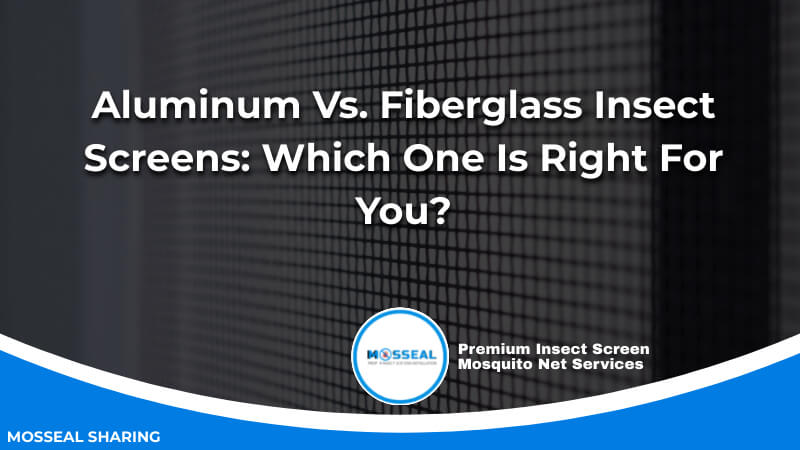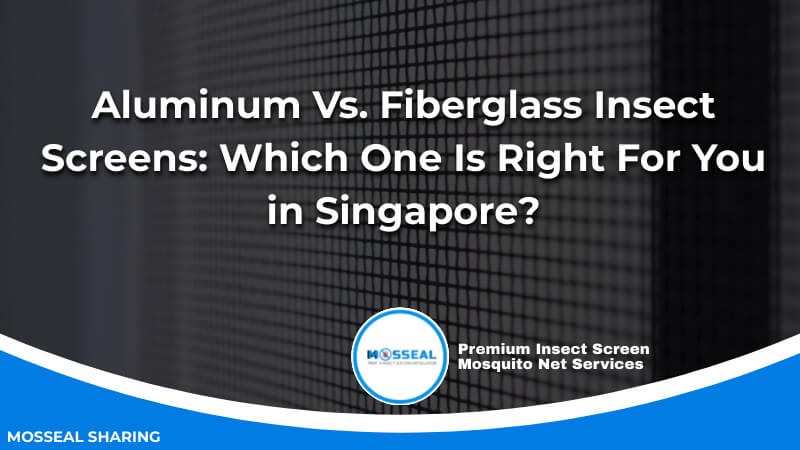Aluminum Vs. Fiberglass Insect Screens: Which One Is Right For You?
Insect Screen
Welcome to the Premium Insect Screen Mosseal in Singapore! This is written by our certified installer. Have you ever wondered which type of insect screen is right for your needs? It can be not easy to decide between aluminum and fiberglass screens. Both materials have their pros and cons, but ultimately the choice comes down to personal preference.
In this article, I’ll discuss both types of screens in detail so that you can make an informed decision on which one is best for you.
Insect screens are a great way to keep bugs out while still allowing fresh air into your home or office. Aluminum and fiberglass are two popular options for choosing materials for insect screens. Each has its own unique characteristics and benefits that should be considered before making a purchase.
So let’s take a look at what each material offers!
Types Of Insect Screens Singapore
It’s no secret that pest control is a problem in many homes. But you don’t have to put up with pesky bugs any longer – let aluminum and fiberglass insect screens do the hard work for you!
They are designed to keep out all sorts of flying insects, while still providing excellent energy efficiency, color options, ventilation quality, and UV protection. Plus they can give your home a modern look at an affordable price.
These two types of screens offer different benefits depending on what you need. Aluminum screens are lightweight and easy to install but may not provide as much ventilation or insulation compared to fiberglass.
Fiberglass screens are heavier-duty and last longer over time, but also come with more restricted airflow than aluminum does. Both materials will protect against pests without blocking too much airflow; however, if you’re looking for something more durable then fiberglass might be the way to go.
Durability And Maintenance
When considering the best insect screen for your home, durability, and maintenance are important factors to consider. Aluminum screens offer strong weather resistance, making them great at keeping out wind-borne bugs like moths and butterflies. They’re also more durable compared to fiberglass screens, meaning they don’t require as much repair over time.
In addition:
- UV protection: Aluminum is better able to withstand harsh sunlight compared to fiberglass, which can degrade with prolonged exposure to UV rays.
- Bug prevention: As mentioned, aluminum offers good bug protection due in part to its strong material composition.
- Weather resistance: The sturdy metal frame of an aluminum screen makes it highly resistant to rain or snowfall.
Fiberglass screens are a bit easier when it comes to cleaning frequency since their smooth surfaces make wiping away dust and dirt simpler than with aluminum screens. However, their susceptibility to wear from elements such as heat or cold means that repair costs might be higher down the line if not taken care of properly.
No matter which type of screen you choose for your home, both options provide reliable bug protection along with varying levels of weather resistance and UV protection—it just depends on how long you want your investment to last!
Cost Considerations
When deciding on which insect screen is right for you, cost considerations are important.
Aluminum screens tend to be cheaper and easier to install than fiberglass screens, but they may not last as long or provide the same level of protection over time.
Fiberglass screens can be more expensive up-front due to their higher quality construction, but they offer better energy savings and greater ventilation control (including light filtration) when compared with aluminum options.
In addition, if you plan to keep pets in your home then fiberglass might be a better choice since it is harder for them to chew through than aluminum.
Both materials have advantages and disadvantages that must be weighed carefully before making a purchase decision.
When considering a new insect screen for your home, consider both the initial purchasing costs and any potential future energy savings from an improved design – this will help you make an informed decision about what type of screen best suits your needs.
Installation Process
Installing insect screens can be a tricky task and safety should always come first.
According to Mosseal Singapore, when installing any kind of insect screen, it is important to make sure you are aware of the access requirements for each type of frame construction, as well as make sure the screen tensioning will work properly.
Aluminum frames tend to require more tools and technical know-how than fiberglass frames, which makes them better suited for installation by an experienced professional.
When choosing between aluminum or fiberglass insect screens, environmental impacts may also need to be taken into consideration.
Fiberglass has been found to have less of an impact on the environment due to its lightweight material composition and ability to be recycled easily if ever needed.
Aluminum is much heavier but still recyclable though not as often seen in practice as fiberglass.
Ultimately, your personal preferences will depend on both practicality and sustainability considerations when deciding whether aluminum or fiberglass is right for you.
Benefits Of Each Type
When it comes to insect screens, both aluminum, and fiberglass are excellent choices. Aluminum is known for its sturdiness and strength, while fiberglass offers more flexibility and visibility.
Both materials offer a range of benefits that can help protect your home from pesky bugs:
- Safety – Both types provide good protection against insects, keeping you safe in the comfort of your own home.
- Visibility – Fiberglass allows more light into your home, providing better visibility when looking outside.
- Longevity – While aluminum is generally more durable than fiberglass, both will last many years with proper maintenance.
- Ventilation/Energy Efficiency – Both materials allow airflow while also helping to keep energy costs low by trapping or reflecting heat away from your windows during hot weather months.
Choosing between aluminum or fiberglass insect screens depends on personal preference as well as the type of window frame being used and the desired level of visibility and ventilation. Ultimately, either material can be an effective way to keep unwanted pests out of your house while allowing enough airflow for comfortable living conditions all year round!
Frequently Asked Questions

How Long Do Aluminum And Fiberglass Insect Screens Typically Last?
When it comes to deciding between aluminum and fiberglass insect screens, one of the biggest factors to consider is how long they typically last.
If you’re looking for durability, then there’s a lot to weigh in terms of cost analysis, insect resistance, design options, and DIY installation.
Aluminum screens are known for their longevity as well as being relatively easy to install yourself.
On the other hand, fiberglass screens may have a shorter lifespan but tend to be more resistant to insects.
Ultimately it all depends on what works best for your home or business.
How Much More Expensive Are Fiberglass Insect Screens Compared To Aluminum Ones?
When it comes to comparing the durability and maintenance costs of aluminum vs. fiberglass insect screens, you may be wondering how much more expensive fiberglass is compared to aluminum ones.
Generally speaking, fiberglass insect screens tend to cost a bit more upfront than aluminum, but they offer several benefits that could make them worth the extra investment over time.
They provide superior energy efficiency, sound insulation, and UV protection – all things that can help reduce your overall maintenance costs in the long run.
Additionally, fiberglass insect screens are considered to be far more durable than their aluminum counterparts, meaning fewer repairs or replacements will likely be needed down the line.
Are Aluminum Or Fiberglass Insect Screens More Effective At Keeping Out Insects?
When deciding whether aluminum or fiberglass insect screens are more effective, it really comes down to the individual needs of each homeowner.
For example, if ease of cleaning is a major concern, then aluminum may be the right choice as it can usually just be wiped with a damp cloth.
On the other hand, if temperature control and energy efficiency are key priorities for you, then fiberglass screens offer better insulation properties than aluminum ones.
Additionally, when looking at soundproofing ability and visibility levels, both materials have their advantages; however, fiberglass typically offers higher transparency due to its mesh construction.
Ultimately, taking all factors into consideration will help make an informed decision on which type of screen best suits your home.
Are Aluminum Or Fiberglass Insect Screens More Aesthetically Pleasing?
When it comes to aesthetics vs. function, choosing between aluminum or fiberglass insect screens can be difficult.
For color selection, both materials come in a variety of colors, but fiberglass is more likely to stay true to its original shade over time due to its superior durability over aluminum.
Installation-wise, aluminum tends to be easier and cheaper than fiberglass for most DIY projects. However, if you want your screen material to last longer then investing in the costlier yet more durable fiberglass option might be worth considering.
Is It Easy To Install Either Type Of Insect Screen Yourself?
Installing new insect screens yourself can save you money, but it’s important to consider if the material of your choice is easy to install.
If you’re wondering whether aluminum or fiberglass insect screens are simpler for a DIY project, both come with their own advantages and disadvantages.
Aluminum is generally more affordable than fiberglass and easier to maintain but may require some additional support during installation.
Fiberglass is usually less expensive in terms of materials but tends to be trickier to set up properly due to its lightweight and flimsy nature.
Consider price comparison and material maintenance when making your decision on which one is right for you!
Choose the Right Type of Insect Screen Singapore
Making the decision between aluminum and fiberglass insect screens can be difficult. Both types of screens have their advantages, but which one is right for you?
It all comes down to your individual needs. If longevity is a top priority, then aluminum screens may be best as they typically last longer than fiberglass ones.
However, if aesthetics are more important to you, then fiberglass might be the way to go since it has a sleeker look. Likewise, if you want something that will keep out insects effectively while not breaking the bank, then aluminum could be just what you’re after due to its lower cost compared with fiberglass.
At the end of the day, choosing between these two options really boils down to finding a balance between functionality and budget – much like life itself! As an old adage goes: “You get what you pay for”.
So consider carefully before making your choice so that you don’t regret it in the future – no matter which option suits your needs better.

Back to the Mosseal Insect Screen page.
